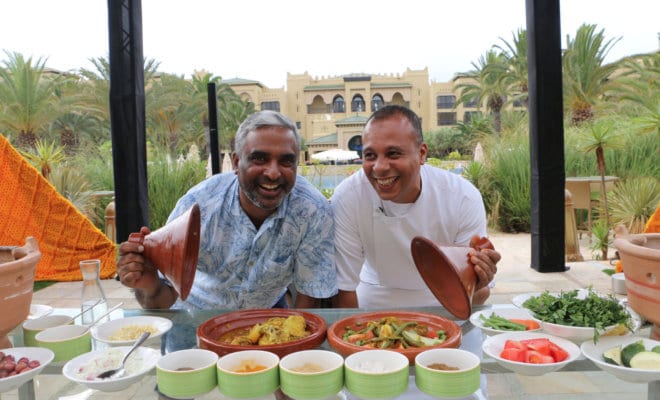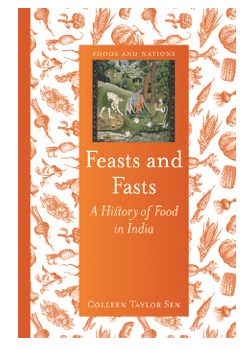Food
Who Stole My Spice

Chef Bakshish Dean (left ) with chef Mohammed: “Indian cuisine is one of the few cuisines in the world where you do not go with complementing flavors.”
A new generation of Indian chefs is seeking to revive Indian cuisine and its accompanying spices.
On a crisp Spring day, in a section of Bloomington, a small university town in Indiana, the air was redolent with more than the hint of spring cress and pasture roses that typically bloom during this time of the year in the Midwest. An intent crowd of 300 culinary arts students from the University of Indiana gathered at the iconic Showalter Fountain and watched in awe as Indian spices, such as Kerala green pepper corns, khus ki jur (poppy seed roots) and mace, crackled in dollops of ghee.
Nishant Choubey, a visiting chef from India, who was a part of an event titled Indian Remix during his visits to universities in Indiana and Michigan, was demonstrating to students how spices in Indian food lend a very characteristic and sophisticated touch. Keeping this philosophy in mind, he chose lamb nihari, a robust, flavorful dish, simmered in an aromatic broth as his first showcase.

Nishant Choubey “Spices in Indian cooking is not to discomfort you, but to enhance your experience.”
Choubey says: “I used star anise, green cardamom, mace before adding onions to build up a flavor profile. I progressed to more complex spices, such as dagad phool (black stone flower found in the Chettinad region of India), and finished the nihari with zafraan. The result of this amalgamation of various spices and ingredients was a mildly flavored almost ambrosial dish.” For his next course, Choubey chose panch phoran aloo, to stress the variation of spices. Here he used fennel, mustard and methi in a preparation to give a stimulation to the senses. After rounding off his demo with kasundi fish and khubani ki kheer, Choubey, executive sous chef at The Roseate Hotel in New Delhi, announced, “Spices in Indian cooking is not to discomfort you, but to enhance your experience.”
Choubey is among a new generation of Indian chefs seeking to revive Indian cuisine and its accompanying spices. The West has had a betwixt and between relationship with spices in Indian food. Food historians blame this misunderstanding on the fact that authentic Indian food in all its complexity never really traveled outside India until recently. Even though curry houses were established nearly two centuries earlier in Britain, bringing Indian cuisine to the world platter, it lacked authenticity on two counts. Because of the unavailability of indigenous ingredients, the earliest cooks catering to western consumers relied on fewer, available spices, and hence the balance was lost. While Indian food rose in popularity as a cheap take-out option, it earned a reputation as being spicy or hot. Years later, in an attempt to woo the Western palette, the curry houses began tapering the levels of spices so people used to blander tastes could find Indian food savory without the heat.
However, as Western gastronomes look East for food philosophies and spices, such as turmeric and caraway, which have earned respectable spots in healthy eating, there is a genuine desire to understand the cuisine. At the recently concluded Research Chef’s Annual Conference in Savannah, GA, Gerry Ludwig, corporate consulting chef of Gordon Food Service, listed three trends bubbling up on menus in New York, Los Angeles and Chicago as vegetables, Brazilian tapioca and Indian cuisine.
Ludwig and his team, which has been visiting restaurants to sample dishes and sense trends for the past 16 years, predict that Indian cuisine, which is a niche in the United States, will continue to gain steam as chefs merge India-centric ingredients and flavors.
MODERN INDIAN,MINUS THE SPICE?
But would the new chefs who are popularizing Indian food abroad want to see a tapered down, lowered spice version of Indian food? “Absolutely not,” says Chef Bakshish Dean, who is regarded as a pioneer of modern Indian cuisine in India.
Dean says: “Indian cuisine is one of the few cuisines in the world where you do not go with complementing flavors. Now to create a dish with completely opposite flavors definitely would have required some real research. But sadly, for the longest time, Indian food in the West was prepared by people who did not understand the philosophy or followed the real regulations of cooking. Fearing that the West would not be able to handle so many spices, they began toning it down to survive in their business.”
New research confirms Chef Dean’s observation about disparate flavors that make up Indian cuisine. A study by Indian Institute of Technology, Jodhpur, researchers of 2,000 Indian recipes concluded that Indian cuisine is characterized by strong negative food pairings, that is the flavors of ingredients in Indian cuisine don’t overlap. By contrast, the flavors of ingredients in Western cuisine overlap. Spices occupy a unique position in the ingredient composition in Indian cuisine and are the most critical contributor to the negative pairing.
“Each of the spices is uniquely placed in its recipe to shape the flavor sharing pattern with rest of the ingredients,” according to the study.
Is modern Indian food tampering with spices as well? Chef Dean says, “The answer would be both yes and no.”
He explains: “It may be true in places where people want to make a quick buck and hence they tweak the food. But today a lot of Indian chefs are making a genuine effort to retain the puritan approach.”
The modern Indian spin is healthy, he says: “Indian food is very rich, not just in ingredients, but in culture, colors and taste. But it was repeatedly being served in bowls, without enhancing the experience that lay there. Over the years the recipes got commercialized and usage of fat increased thus making them unhealthy. Modern Indian food was an original attempt to evaluate the real recipes and their nutritive values. The idea was to present them in interesting formats with some modern surprises. The modern surprises were meant to be always around the recipe, to stress its versatility, and never in it.”
ARE YOU A SPICE SNOB?
Food historians point out that spices, which today are regarded as the mainstay of Indian cuisine, were not always exclusive to us. Sixteenth century Europe saw a generous use of spices. In fact, some of the contrasting flavors were frequently seen in preparations of those times. So when and how did the West develop an uneasy relationship with spices? Colleen Taylor Sen, a Chicago-based culinary historian and author of Feasts and Fasts: A History of Food in India, says: “The history of the West with spices is complicated. In the Middle Age spices were expensive and available only to the elite. Spices, which were also valued for their medical benefits, were used in abundance in dishes and in unusual ways. Even in the early 16th century, English food among the wealthy was heavy with cumin, caraway, ginger, pepper, cinnamon, cloves, and nutmeg. So, the first English people in India did not find Indian food so strange. There was also a custom of eating some sweet spices after a meal to aid digestion and to freshen the breath — a custom similar to supari.”
But confirming how food also plays a role in class and society, Sen says, “As spices became less expensive, their prestige value declined and they were used only selectively.”

Salma Husain “There are stories on how mullingtawny soup was removed from the menu as it was Indian.”
How spices may have curiously tracked the social pecking order was also noted by food historian and author Salma Husain. When she was researching the history of Indian food during the pre-independence era for her book, Around India’s First Table: Dining and Entertaining at the Rashtrapati Bhavan, Husain says: “The Western notion of superiority was reflected in their food choices. During my research, I found out that the English viceroys who occupied the Rashtrapati Bhavan never had Indian or spicy food cooked in their kitchens. They would only have French food in an attempt to break free from what the ‘poor’ Indians were eating. In fact there are stories on how mullingtawny soup was removed from the menu as it was Indian. The English sahibs with their bias inched away from spices that were common man’s food in India.”
She adds, “It was only after Dr Zakir Hussain came in and brought along Hyderabadi cooks that Indian food was introduced in Rashtrapati Bhavan.”
As the confluence between cultures expanded, the British also made a conscious attempt to not emulate Indian practices. Husain says: “Even when you see Anglo-Indian cuisine, you will note that various methods have been alternated. So khicri became kedgeree, kormas were replaced by pies and spices turned scant.”
Industrialization also contributed to the decline of spices in the West. Chef Dean says: “Historically, spices played another very important role for preservation. Various civilizations used spices to ensure the longevity of perishable cooked food. But post-industrial revolution and the coming of refrigerator, this aspect was taken care of in Europe and America and the spices increasingly became milder. India, being a poor and rural nation by contrast, did not have refrigerators. In fact, 80 percent of rural India still would not have a refrigerator (A 2016 study found that fewer than 30 percent of Indian households had refrigerators) and pickling and spices continue as popular cooking techniques.”
SPICE IN AMERICA
While colonialization was one route Indian food followed to Europe, its path to America is harder to trace, and principally known only anecdotally. According to several historical references, in the early 1920s, a handful of Indian restaurants, such as Taj Mahal Hindu and Ceylon India, opened in New York.
While Americans have become increasingly familiar with Indian food since the 1960s, its craft and the quality has for the most part been poor. Rahul Shrivastav, executive director of dining at Indiana University says: “I am particularly disappointed that increasingly distorted dishes, such as sugar laced butter chicken, are passed off as Indian food in the United States. When it comes to spices that add value to the cuisine, even at Lexington Avenue in New York, 75 percent of restaurants play safe. It is perhaps the forgotten art of right seasoning that has led us to where we are with Indian food, here in the States.”

Colleen Taylor Sen “As spices became less expensive, their prestige value declined and they were used only selectively.”
The American resistance to sharp spices also led many early mom and pop restaurants to eschew precious spices such as cinnamon, clove, cumin, cardamom, etc. Shrivastav blames the resistance on the American comfort factor: “Every day as part of my work we feed 50,000 people. We do a lot of variation in our cooking from Korean to Mexican cuisine, but still 75 percent of our students end up eating burgers and fries — because it’s comfort food for them.”
Dr Taylor-Sen says, “In my opinion, much Indian food in North America is years behind that served in India. It reflects the food that people knew when they emigrated — a phenomenon common to all immigrant communities. Tandoori chicken, butter chicken, samosas and saag panir are the most popular dishes in many restaurants, while South Indian food remains the standard for vegetarian diners. There are exceptions, especially in New York City, where restaurants such as Indian Accent, Junoon, Table, Paowalla and Haldi, offer sophisticated and diverse dishes in elegant settings.”
Spices became integral to Indian curries because of trade routes, Chef Choubey says: “India and Sri Lankas’s geography situated them at the nexus of the spice trade. The monsoon winds made it easy for Arab traders to get across the Indian ocean at the right time of the year, and the famed spice islands of Java sent cloves and pepper east to India.”
He adds: “Owing to ideal conditions, Indian cooks are lucky to understand the better spice mix better as compared to the western cooks. Black pepper and cardamom grew in vast forests of India and over time more and more spices migrated from both East and West and took up cultivation on the Malabar Coast. That’s predominantly why Indian cuisine came to rely on spices. But spice remains a confused word (in the West) as its only considered to be chili, whereas Indian spice mix is a blend of 101 spice starting from cinnamon to stone flower to khus root and pipli.”
The revivers of Indian cuisine are aiming to restore the glory that spice commands.
| THE ROLE OF SPICE IN INDIAN FOOD
by Colleen Taylor Sen The use of spices goes back to the Indus Valley civilization (3000-1500 BCE ) where turmeric, ginger and garlic were used as flavorings. More than 100 spices have been identified in India. Spices are perhaps the most characteristic feature of Indian cuisine. Their use varies widely depending on region, religion and individual households.
Many explanations have been offered for the intensive use of spices in India, Mexico, and other hot countries — and most are myths. Hot spices do not, for example, induce enough perspiration to cool our bodies down. Nor do they mask the flavor of tainted meat, since those who eat such food would be likely to fall ill and die! Spices provide nutrients, such as Vitamin A and C, but in very small amounts. The latest theory, backed by a body of scientific evidence, is that a taste for spices evolved over the centuries in hot climates because they contain powerful antibiotic chemicals that can kill or suppress the bacteria and fungi that spoil foods. Some spices can kill or stop the growth of dozens of species of bacteria, the most potent being garlic, onion, allspice, cinnamon, cumin, cloves and chilies. The antibiotic effects are even more potent when spices such as chilies, onions, garlic, and cumin are combined with each other. People often equate the use of spices with hotness. Hotness, i.e., a burning sensation in the mouth, is produced by black pepper and chilies. The pungency of pepper is due to the volatile oil piperine and resin, which increase the flow of saliva and gastric juices. Chilies’ hotness is produced by capsaicin, an alkaloid found mainly in the membranes lining the pod. Generally speaking, food in South Indian tends to be hotter than that in the north, although Pakistani food can also be quite mouth-searing. From a gastronomical standpoint, the purpose of spices is to add flavor, texture and body to a dish. They also provide flavor and excitement at low cost for poor people whose diet is otherwise bland and unvarying. In preparing simple vegetable dishes cooks may use just two or three spices, whereas more complex meat dishes are made with a dozen or more. Spices may be added once, twice, even three times during the cooking process. They may be ground into a powder or masala (which means mixture), used whole, (especially peppercorns, cardamom, and cloves), or ground with water, chilies, and onions, yogurt, or tomatoes to make a paste. Spices generally are dry-roasted or slightly fried first to intensify their flavor. |


1 Comment
You must be logged in to post a comment Login